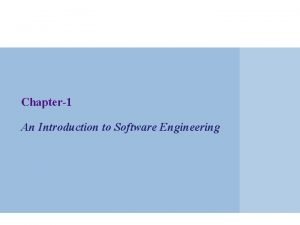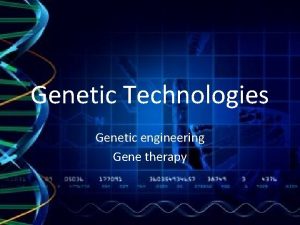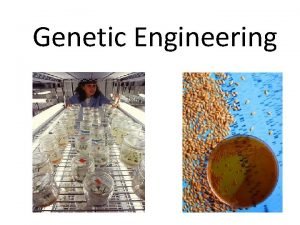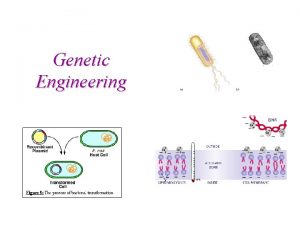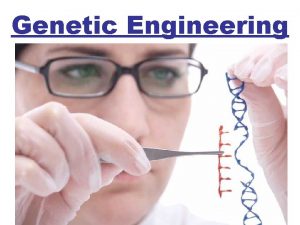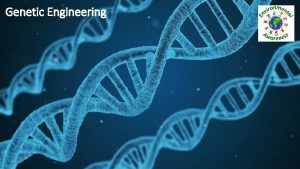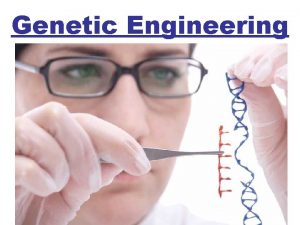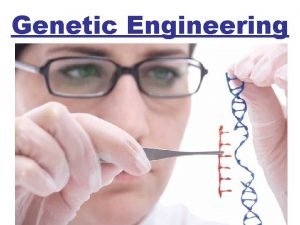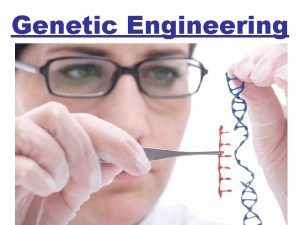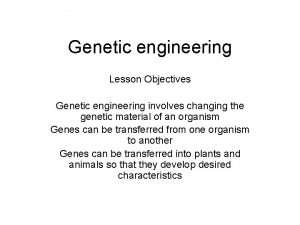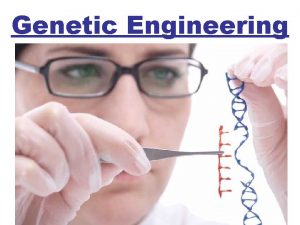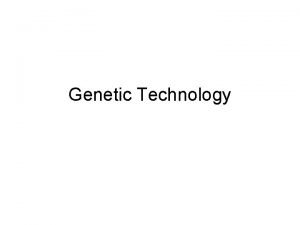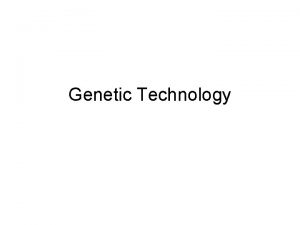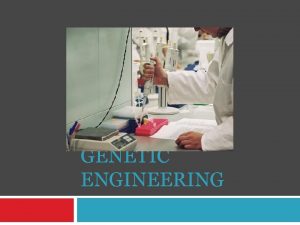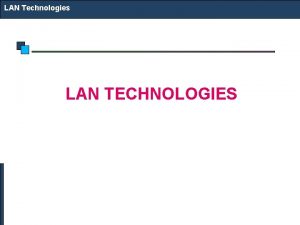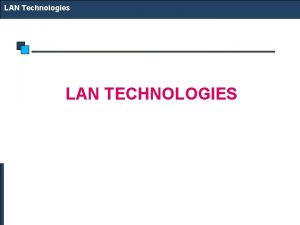Genetic Technologies Genetic Engineering Genetic engineering Changing the
























- Slides: 24

Genetic Technologies

Genetic Engineering • Genetic engineering: Changing the DNA in living organisms to create something new. • This organisms are called Genetically Modified Organism • (GMO) Genetically Modified organism are called transgenic organism; since genes are transferred from one organism to another. Genetic Engineering Techniques 1. Artificial selection A. selective breeding B. hybridization 2. Cloning / Gene splicing 3. CRISPR –CAS 9

Artificial Selection Artificial selection: breeders choose which organism to mate to produce offspring with desired traits. • • They cannot control what genes are passed. When they get offspring with the desired traits, the maintain them. Types of artificial selection: A. selective breeding B. hybridization

A. Selective breeding: when animals with desired characteristics are mated to produce offspring with those desired traits. • Passing of important genes to next generation. • Example: Champion race horses, cows with tender meat, large juicy oranges on a tree.

Selective Breading Process • Selective breeding occurs when you choose the best male and female to breed. • This allows you to fine tune and control the traits • The offspring or babies will then be more likely have the best traits. • Then you continue to breed those organism with the best traits, those traits will be maintained.

Selective breading example • For example people breed dogs for specific purposes. • Dachshund were once bred to hunt badgers and other burrowing animals. • They must be small to fit into the animals hole in the ground.

B. Hybridizations: two individuals with unlike characteristics are crossed to produce the best in both organisms. • Example: Luther Burbank created a disease resistant potato called the Burbank potato. • He crossed a disease resistant plant with one that had a large food producing capacity. • Result: disease resistant plant that makes a lot of potatoes.

Cloning - Clones are organisms that are exact genetic copies. - Cloning is the process of making an exact genetic copy of a gene or a entire organism The following are three types of cloning technologies: • (1) recombinant DNA technology or DNA cloning • (2) reproductive cloning • (3) therapeutic cloning.

Recombinant DNA Technology or DNA Cloning • The terms "recombinant DNA technology, " "DNA cloning, " "molecular cloning, "or "gene cloning" all refer to the same process: • the transfer of a DNA fragment of interest from one organism to a self-replicating genetic element such as a bacterial plasmid. • The DNA of interest can then be propagated in a foreign host cell. This technology has been around since the 1970 s, and it has become a common practice in molecular biology labs today.

Bacterial Plasmids • Scientists studying a particular gene often use bacterial plasmids to generate multiple copies of the same gene. Plasmids are self-replicating extra-chromosomal circular DNA molecules • Endonucleases (restriction enzymes) -Enzymes that “cut” DNA in a sequence-specific manner

Clone a gene • To "clone a gene, " a DNA fragment containing the gene of interest is isolated (CUT) from chromosomal DNA using restriction enzymes and then united with a plasmid that has been cut with the same restriction enzymes. • When the fragment of chromosomal DNA is joined with its plasmid in the lab, it is called a "recombinant DNA molecule. " DNA Ligase finished the process by binding the sugar and phosphates together • Following introduction into suitable host cells, the recombinant DNA can then be reproduced along with the host cell DNA


Reproductive Cloning • Reproductive cloning is a technology used to generate an animal that has the same nuclear DNA as another currently or previously existing animal • In a process called "somatic cell nuclear transfer" (SCNT), scientists transfer genetic material from the nucleus of a donor adult cell to an egg whose nucleus, and thus its genetic material, has been removed. • The reconstructed egg containing the DNA from a donor cell must be treated with chemicals or electric current in order to stimulate cell division. • Once the cloned embryo reaches a suitable stage, it is transferred to the uterus of a female host where it continues to develop until birth.

Human Cloning • Somatic cell nuclear transfer • Human repair kit, they can grow organs such as hearts, livers, and skins.

Therapeutic Cloning • Therapeutic cloning, also called "embryo cloning, " is the production of human embryos for use in research. The goal of this process is not to create cloned human beings, but rather to harvest stem cells that can be used to study human development and to treat disease. • Stem cells are important to biomedical researchers because they can be used to generate virtually any type of specialized cell in the human body • Many researchers hope that one day stem cells can be used to serve as replacement cells to treat disease

How can cloning technologies be used? • Recombinant DNA technology is important for learning about other related technologies, such as gene therapy, genetic engineering of organisms, and sequencing genomes. • Gene therapy can be used to treat certain genetic conditions by introducing virus vectors that carry corrected copies of faulty genes into the cells of a host organism. • reproductive cloning can be used to develop efficient ways to reliably reproduce animals with special qualities. • For example, drug-producing animals or animals that have been genetically altered to serve as models for studying human disease could be mass-produced.

More Cloning technologies • Genes from different organisms that improve taste and nutritional value or provide resistance to particular types of disease can be used to genetically engineer food crops. • Therapeutic cloning technology may some day be used in humans to produce whole organs from single cells or to produce healthy cells that can replace damaged cells in degenerative diseases such as Alzheimer's or Parkinson's

What animals have been cloned? • Hundreds of cloned animals exist today, but the number of different species is limited. Attempts at cloning certain species such as monkeys, chickens, horses, and dogs, have been unsuccessful. Some species may be more resistant to somatic cell nuclear transfer than others. • The process of stripping the nucleus from an egg cell and replacing it with the nucleus of a donor cell is a traumatic one, and improvements in cloning technologies may be needed before many species can be cloned successfully.

Organ Transplantation • Thousands of people die every year waiting for a transplant • Cloning technology could someday be used to produce whole organs. • Embryonic stem cells also have the potential for use in the production of tissues.

What are the risks of cloning? • Reproductive cloning is expensive and highly inefficient. More than 90% of cloning attempts fail to produce viable offspring. More than 100 nuclear transfer procedures could be required to produce one viable clone. • In addition to low success rates, cloned animals tend to have more compromised immune function and higher rates of infection, tumor growth, and other disorders. • Many cloned animals have not lived long enough to generate good data about how clones age. • Clones have been known to die mysteriously. For example, Australia's first cloned sheep appeared healthy and energetic on the day she died, and the results from her autopsy failed to determine a cause of death.

CRISPR- CAS 9 • CRISPR is the newest, most efficient and most accurate method (out of many) to edit a cell's genome. • CRISPR/Cas 9 has been used to edit the genomes of cultured mouse cells or human cells. • CRISPR/Cas 9 is ridiculously versatile. Not only can scientists use CRISPR to “silence” genes by snipping them out — they can also harness repair enzymes to substitute in desired genes into the “hole” left by the snippers (though this latter technique is trickier to pull off). • So, for instance, scientists could tell the Cas 9 enzyme to go snip out the incorrect base in the gene that causes Cystic Fibrosis and insert a “good” base to fix the gene.

How it works • CRISPR uses RNA as a template to guide its way to a specific DNA sequence • Then the endonucleases make precise cuts on the double stranded DNA • After cuts are made the amazing part takes place. Repairing, replacing, or removing bases or entire genes. • What makes CRISPR so revolutionary is that it’s incredibly precise: • • The Cas 9 enzyme mostly goes wherever you tell it to go. It’s incredibly cheap and easy: In the past, it might have cost thousands of dollars and weeks or months of fiddling to alter a gene. Now it might cost just $75 and only take a few hours. And this technique has worked on every organism it’s been tried on

What can CRISPR actually do • At the most basic level, CRISPR can make it much easier for researchers to figure out what different genes in different organisms actually do — by, for instance, knocking out individual genes and seeing what traits are affected. • This is important: While we’ve had a complete “map” of the human genome since 2003, we don’t really know what function all those genes serve. CRISPR can help speed up genome screening, and genetics research could advance massively as a result.

CRISPR the Next Level • Edit crops to be more nutritious: Crop scientists are already looking to use CRISPR to edit the genes of various crops to make them tastier, or more nutritious, or better survivors of heat and stress. • New tools to stop genetic diseases: As the new Nature paper shows, scientists are now using CRISPR/Cas 9 to edit the human genome and try to knock out genetic diseases like hypertrophic cardiomyopathy • Create powerful new antibiotics and antivirals • Gene drives could alter entire species: Scientists have also demonstrated that CRISPR could be used, in theory, to modify not just a single organism but to modify an entire species • Creating “designer babies. ” This is the one that gets all the attention. It’s not entirely far-fetched to think we might one day use CRISPR to edit the human genome — to eliminate disease, or select for athleticism, or for superior intelligence
 Evolutionary drift
Evolutionary drift Genetic programming vs genetic algorithm
Genetic programming vs genetic algorithm Genetic programming vs genetic algorithm
Genetic programming vs genetic algorithm What is the difference between genetic drift and gene flow
What is the difference between genetic drift and gene flow What is the difference between genetic drift and gene flow
What is the difference between genetic drift and gene flow Introduction to software engineering
Introduction to software engineering Hình ảnh bộ gõ cơ thể búng tay
Hình ảnh bộ gõ cơ thể búng tay Slidetodoc
Slidetodoc Bổ thể
Bổ thể Tỉ lệ cơ thể trẻ em
Tỉ lệ cơ thể trẻ em Chó sói
Chó sói Tư thế worm breton là gì
Tư thế worm breton là gì Chúa yêu trần thế alleluia
Chúa yêu trần thế alleluia Các môn thể thao bắt đầu bằng từ đua
Các môn thể thao bắt đầu bằng từ đua Thế nào là hệ số cao nhất
Thế nào là hệ số cao nhất Các châu lục và đại dương trên thế giới
Các châu lục và đại dương trên thế giới Công thức tính thế năng
Công thức tính thế năng Trời xanh đây là của chúng ta thể thơ
Trời xanh đây là của chúng ta thể thơ Cách giải mật thư tọa độ
Cách giải mật thư tọa độ Làm thế nào để 102-1=99
Làm thế nào để 102-1=99 độ dài liên kết
độ dài liên kết Các châu lục và đại dương trên thế giới
Các châu lục và đại dương trên thế giới Thể thơ truyền thống
Thể thơ truyền thống Quá trình desamine hóa có thể tạo ra
Quá trình desamine hóa có thể tạo ra Một số thể thơ truyền thống
Một số thể thơ truyền thống





